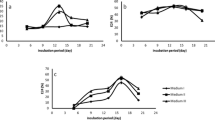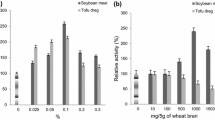Abstract
The effects of two biosurfactants, tea saponin (TS) and rhamnolipid (RL), on the production of laccase and the degradation of phenol by P. simplicissimum were investigated in solid-state fermentation consisting of rice straw, rice bran, and sawdust. Firstly, the effects of phenol on the fermentation process were studied in the absence of surfactants. Then, a phenol concentration of 3 mg/g in the fermentation was selected for detailed research with the addition of biosurfactants. The results showed that TS and RL at different concentrations had stimulative effects on the enzyme activity of laccase. The highest laccase activities during the fermentation were enhanced by 163.7%, 68.2%, and 23.3% by TS at concentrations of 0.02%, 0.06%, and 0.10%, respectively. As a result of the enhanced laccase activity, the efficiency of phenol degradation was also improved by both biosurfactants. RL caused a significant increase of fungal biomass in the early stage of the fermentation, while TS had an inhibitory effect in the whole process. These results indicated that RL could mitigate the negative effects of phenol on fungal growth and consequently improve laccase production and phenol degradation. TS was potentially applicable to phenol-polluted solid-state fermentation.



Similar content being viewed by others
References
Caza, N., Bewtra, J. K., Biswas, N., & Taylor, K. E. (1999). Removal of phenolic compounds from synthetic wastewater using soybean peroxidase. Water Research, 33(13), 3012–3018.
Autenrieth, R. L., Bonner, J. S., Akgerman, A., Okaygun, M., & McCreary, E. M. (1991). Biodegradation of phenolic wastes. Journal of Hazardous Materials, 28(1–2), 29–53.
Zhao, G. H., Zhou, L. C., Li, Y. F., Liu, X. X., Ren, X. J., & Liu, X. L. (2009). Enhancement of phenol degradation using immobilized microorganisms and organic modified montmorillonite in a two-phase partitioning bioreactor. Journal of Hazardous Materials, 169(1–3), 402–410.
Banerjee, I., Modak, J. M., Bandopadhyay, K., Das, D., & Maiti, B. R. (2001). Mathematical model for evaluation of mass transfer limitations in phenol biodegradation by immobilized Pseudomonas putida. Journal of Biotechnology, 87, 211–223.
Fraaije, M. W., Pikkemaat, M., & Van Berkel, W. J. H. (1997). Enigmatic gratuitous induction of the covalent flavoprotein vanillyl-alcohol oxidase in Penicillium simplicissimum. Applied and Environmental Microbiology, 63(2), 435–439.
Rocha, L. L., Aguiar Cordeiro, R., De Cavalcante, A. E., Nascimento, R. M., Do, R. F., Silveira Martins, S. C., et al. (2007). Isolation and characterization of phenol-degrading yeasts from an oil refinery wastewater in Brazil. Mycopathologia, 164, 183–188.
Mollaei, M., Abdollahpour, S., Atashgahi, S., Abbasi, H., Masoomi, I., Rad, F., et al. (2010). Enhanced phenol degradation by Pseudomonas sp. SA01: gaining insight into the novel single and hybrid immobilizations. Journal of Hazardous Materials, 175(1–3), 284–292.
Annachhatre, A. P., & Gheewala, S. H. (1996). Biodegradation of chlorinated phenolic compounds. Biotechnology Advances, 14, 35–56.
Niladevi, K. N., & Prema, P. (2008). Immobilization of laccase from Streptomyces psammoticus and its application in phenol removal using packed bed reactor. World Journal of Microbiology & Biotechnology, 24, 1215–1222.
Bollag, J. M., Shuttleworth, K. L., & Anderson, D. H. (1988). Laccase-mediated detoxification of phenolic compounds. Applied and Environmental Microbiology, 54, 3086–3091.
Thurston, C. F. (1994). The structure and function of fungal laccases. Microbiology, 140, 19–26.
Petri, W., & Andreas, K. (2008). Laccase application in the forest products industry: a review. Enzyme and Microbial Technology, 42, 293–307.
Zeng, G. M., Yu, H. Y., Huang, H. L., Huang, D. L., Chen, Y. N., Huang, G. H., et al. (2006). Laccase activities of a soil fungus Penicillium simplicissimum in relation to lignin degradation. World Journal of Microbiology and Biotechnology, 22, 317–324.
Zeng, G. M., Shi, J. G., Yuan, X. Z., Liu, J., Zhang, Z. B., Huang, G. H., et al. (2006). Effects of Tween 80 and rhamnolipid on the extracellular enzymes of Penicillium simplicissimum isolated from compost. Enzyme and Microbial Technology, 39, 1451–1456.
Ahuja, S. K., Ferreira, G. M., & Moreira, A. R. (2004). Production of an endoglucanase by the shipworm bacterium Teredinobacter turnirae. Journal of Industrial Microbiology & Biotechnology, 31, 41–47.
Reddy, R. M., Reddy, P. G., & Seenayya, G. (1999). Enhanced production of thermostable-amylase and pullulanase in the presence of surfactants by Clostridium thermosulfurogenes SV2. Process Biochemistry, 34, 87–92.
Liu, X. L., Zeng, G. M., Tan, L., Zhong, H., Wang, R. Y., Fu, H. Y., et al. (2008). Effects of dirhamnolipid and SDS on enzyme production from Phanerochaete chrysosporium in submerged fermentation. Process Biochemistry, 43, 1300–1303.
Helle, S. S., Duff, S. J. B., & Cooper, D. G. (1993). Effect of surfactants on cellulose hydrolysis. Biotechnology and Bioengineering, 42(5), 611–617.
Liu, Z. F., Zeng, G. M., Wang, J., Zhong, H., Ding, Y., & Yuan, X. Z. (2010). Effects of monorhamnolipid and Tween 80 on the degradation of phenol by Candida tropicalis. Process Biochemistry, 45(5), 805–809.
Zhong, H., Zeng, G. M., Liu, J. X., Xu, X. M., Yuan, X. Z., Fu, H. Y., et al. (2008). Adsorption of monorhamnolipid and dirhamnolipid on two Pseudomonas aeruginosa strains and the effect on cell surface hydrophobicity. Applied Microbiology and Biotechnology, 79, 671–677.
Bourbonnais, R., Paice, M. G., Freiermuth, B., Bodie, E., & Borneman, S. (1997). Reactivities of various mediators and laccases with kraft pulp and lignin model compounds. Applied and Environmental Microbiology, 63(12), 4627–4632.
Ruzicka, S., Norman, M. D. P., & Harris, J. A. (1995). Rapid ultrasonication method to determine ergosterol concentration in soil. Soil Biology and Biochemistry, 27, 1215–1217.
Jiang, Y., Wen, J. P., Li, H. M., Yang, S. L., & Hu, Z. D. (2005). The biodegradation of phenol at high initial concentration by the yeast Candida tropicalis. Biochemical Engineering Journal, 24(3), 243–247.
Ryan, D., Leukes, W., & Burton, S. (2007). Improving the bioremediation of phenolic wastewaters by Trametes versicolor. Bioresource Technology, 98, 579–587.
Volkering, F., Breure, A. M., & Rulkens, W. H. (1998). Microbiological aspects of surfactant use for biological soil remediation. Biodegradation, 8, 401–417.
Yang, Z., Deng, J., & Chen, L. F. (2007). Effect of ionic and non-ionic surfactants on the activity and stability of mushroom tyrosinase. Journal of Molecular Catalysis B, Enzymatic, 47, 79–85.
Morikawa, N., Li, N., Nagatomo, A., Matsuda, H., Li, X., & Yoshikawa, M. (2006). Triterpene saponins with gastroprotective effects from tea seed (the seeds of Camellia sinensis). Journal of Natural Products, 69, 185–190.
Noordman, W. H., Brusseau, M. L., & Janssen, D. B. (2000). Adsorption of a multicomponent rhamnolipid surfactant to soil. Environmental Science & Technology, 34, 832–838.
Mougin, C., Jolivalt, C., Briozzo, P., & Madzak, C. (2003). Fungal laccases: from structure–activity studies to environmental applications. Environmental Chemistry, 1, 145–148.
Minussi, R. C., Pastore, G. M., & Durán, N. (2007). Laccase induction in fungi and laccase/N–OH mediator systems applied in paper mill effluent. Bioresource Technology, 98(1), 158–164.
Majeau, J. A., Brar, S. K., & Tyagi, R. D. (2010). Laccases for removal of recalcitrant and emerging pollutants. Bioresource Technology, 101(7), 2331–2350.
Keweloh, H., Weyrauch, G., & Rehm, H. J. (1990). Phenol-induced membrane changes in free and immobilized Escherichia coli. Applied Microbiology and Biotechnology, 33, 66–71.
Rouse, J. D., Sabatini, D. A., Suflita, J. M., & Harwell, J. H. (1994). Influence of surfactants on microbial degradation of organic compounds. Critical Reviews in Environmental Science and Technology, 24(4), 325–370.
Zeng, G. M., Xu, K., Huang, J. H., Li, X., Fang, Y. Y., & Qu, Y. H. (1998). Micellar enhanced ultrafiltration of phenol in synthetic wastewater using polysulfone spiral membrane. Journal of Membrane Science, 310, 149–160.
Li, Y., Du, Y. M., & Zou, C. (2009). Effects of pH on antioxidant and antimicrobial properties of tea saponins. European Food Research and Technology, 228, 1023–1028.
Wina, E., Muetzel, S., Hoffmann, E., Makkar, H. P. S., & Becker, K. (2005). Saponins containing methanol extract of Sapindus rarak affect microbial fermentation, microbial activity and microbial community structure in vitro. Animal Feed Science and Technology, 121, 159–174.
Acknowledgments
This research was financially supported by the National Natural Science Foundation of China (No. 50978087), the Hunan Province Science and Technology Project (2009 FJ-1010-4), the Innovative Research Team in University (IRT0719), and the Hunan University Graduate Education Innovation Project (531107011019).
Author information
Authors and Affiliations
Corresponding author
Rights and permissions
About this article
Cite this article
Zhou, MF., Yuan, XZ., Zhong, H. et al. Effect of Biosurfactants on Laccase Production and Phenol Biodegradation in Solid-State Fermentation. Appl Biochem Biotechnol 164, 103–114 (2011). https://doi.org/10.1007/s12010-010-9118-6
Received:
Accepted:
Published:
Issue Date:
DOI: https://doi.org/10.1007/s12010-010-9118-6




